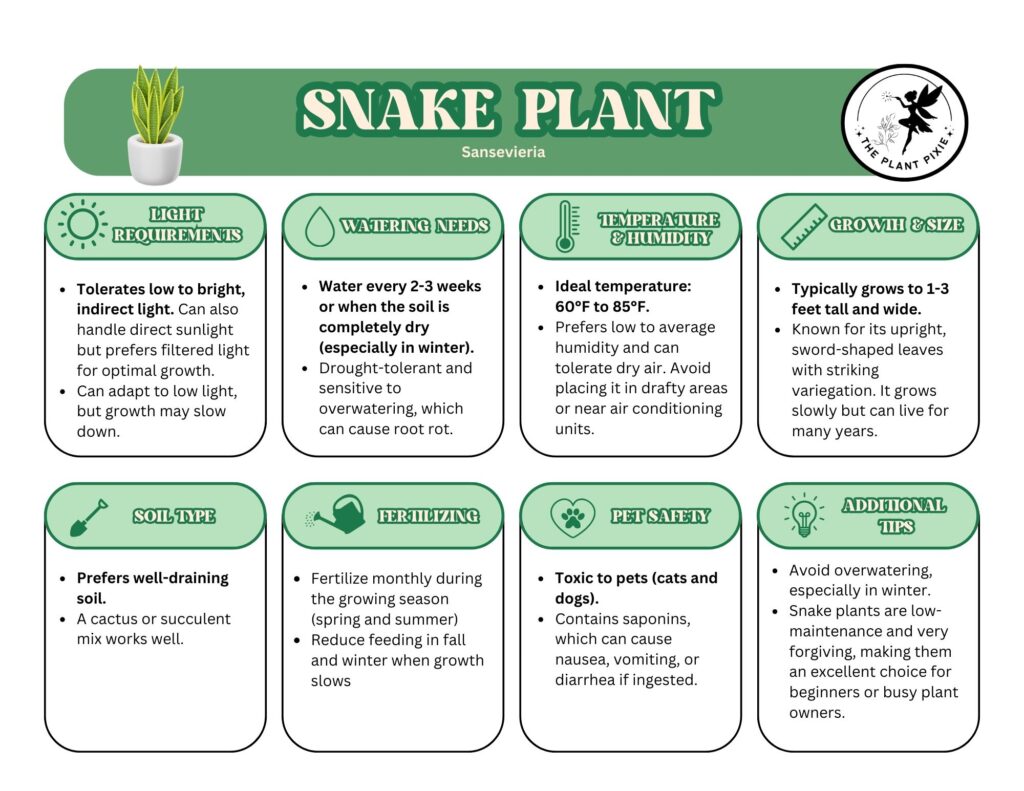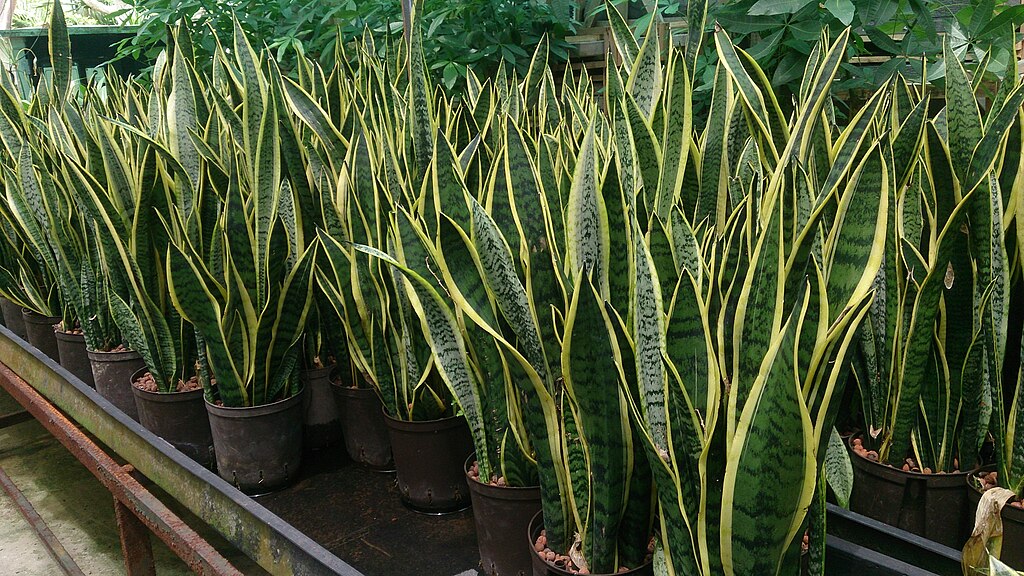
Sansevieria (commonly known as Snake Plant or Mother-in-Law’s Tongue) is a hardy, low-maintenance houseplant renowned for its striking, upright leaves and its ability to thrive in a variety of conditions. It belongs to the Asparagaceae family and is native to West Africa, India, and Southeast Asia.
The plant typically features long, sword-like leaves that can be variegated in shades of green, yellow, or silver, depending on the variety. Sansevieria is an ideal choice for indoor spaces due to its tolerance for low light, minimal watering needs, and air-purifying qualities.
It’s considered a “super easy” plant for beginners and is often praised for being nearly impossible to kill, making it perfect for anyone looking to add some greenery to their home or office without a lot of fuss.
1. What is Sansevieria?
- Botanical Details:
- Family: Asparagaceae
- Genus: Sansevieria (now often classified under Dracaena)
- Common names: Snake Plant, Mother-in-Law’s Tongue
- Native Habitat: Africa, India, and Southeast Asia
- Types and Varieties:
- Sansevieria trifasciata (most common)
- Varieties like ‘Laurentii’, ‘Moonshine’, ‘Silver Queen’, etc.
2. Ideal Growing Conditions:
- Light:
- Tolerates a range from low light to bright indirect light
- Best in indirect light, but can survive low light areas
- Temperature:
- Prefers temperatures between 60-85°F (15-29°C)
- Avoid drafts and temperatures below 50°F (10°C)
- Humidity:
- Adaptable to dry air; no need for high humidity
- Soil:
- Well-draining, sandy or cactus mix
3. Watering and Fertilizing:
- Watering:
When watering a Sansevieria, it’s important to avoid overwatering, as this is one of the most common causes of problems. Sansevierias are drought-tolerant and thrive in dry conditions, so they prefer to dry out completely between waterings. Water the plant thoroughly, but allow the soil to dry out completely before watering again, typically every 2-3 weeks, depending on the season and environment. In the winter, when the plant is in a dormant phase, reduce watering even further. Make sure the pot has good drainage to prevent water from sitting at the bottom, which can lead to root rot. If the leaves start to curl, turn yellow, or develop mushy spots, it could be a sign of overwatering. Conversely, if the leaves start to shrivel or become brittle, it might need more water.
- Fertilizing:
Fertilizing a Sansevieria is relatively simple, as these plants have low nutrient needs. During the growing season (spring and summer), you can fertilize once a month with a balanced, diluted liquid fertilizer (like a 10-10-10 or 20-20-20 formula). Be sure to dilute the fertilizer to about half the recommended strength to avoid overfeeding, as Sansevierias are sensitive to excess nutrients. During the fall and winter months, when the plant is dormant, fertilization is not necessary, and it’s best to refrain from fertilizing until spring. Over-fertilizing can lead to weak, leggy growth, so it’s better to err on the side of caution and fertilize less frequently. Also, ensure that your Sansevieria is healthy and well-watered before applying any fertilizer to prevent root damage.
4. Common Issues & How to Solve Them:
- Yellowing Leaves:
- Causes: Overwatering, poor drainage
- Solutions: Adjust watering schedule, check soil and pot drainage
- Brown Tips:
- Causes: Underwatering, too much direct sunlight
- Solutions: Check moisture levels, adjust placement
- Pests:
- Rare, but may encounter mealybugs, scale, or spider mites
- Solutions: Treat with neem oil or insecticidal soap
- Leggy Growth:
- Causes: Insufficient light
- Solutions: Move to a brighter location or trim leggy stems
5. Propagation Tips:
Propagating a Sansevieria (snake plant) is relatively easy, and there are a few different methods you can use: leaf cuttings, division, or rhizome propagation. Here’s a step-by-step guide for each method, along with potential challenges to watch out for:
Leaf Cutting Propagation (Water Method or Soil Method)
Step-by-Step:
- Select a Healthy Leaf: Choose a healthy, mature leaf and use clean, sharp scissors or a knife to cut it into 4-6 inch sections. Each section should be a few inches long.
- Dry the Cuttings: Allow the cut ends of the leaf segments to dry out for 1-2 days. This helps prevent rot when you plant them.
- Water Method: Place the cuttings upright in a jar or glass of water, making sure the cut end is submerged, but the rest of the leaf is above water. Change the water every few days to prevent stagnation.
- Soil Method: Alternatively, plant the cuttings in a small pot with well-draining cactus or succulent soil. Water lightly and let the soil dry out completely between waterings.
- Wait for Roots: In both methods, roots should start forming within a few weeks. If using water, once the roots are about 1-2 inches long, you can transplant the cutting into soil.
Challenges to Watch Out For:
- Rot: Sansevieria cuttings are prone to rot if they are too wet or left in stagnant water for too long. Be sure to change the water regularly or use well-draining soil.
- Slow Rooting: Snake plant cuttings can be slow to develop roots. Be patient and keep them in a warm, indirect light location to encourage growth.
2. Division (Rhizome Propagation)
Step-by-Step:
- Remove the Plant from Its Pot: Gently remove the parent plant from its pot and shake off the excess soil to expose the rhizomes (the underground stems that produce new growth).
- Divide the Rhizomes: Use a clean, sharp knife or scissors to carefully cut the rhizomes into sections. Each section should have at least one healthy leaf and a bit of root.
- Pot the Divisions: Plant each division in a separate pot with well-draining soil, ensuring the roots are covered but the leaves are above the soil surface.
- Water and Care: Water the new divisions lightly and place them in bright, indirect light. Avoid overwatering, as the roots are still establishing.
Challenges to Watch Out For:
- Infection or Damage: When dividing the rhizomes, be gentle to avoid damaging the roots. Also, make sure to disinfect your tools before use to prevent any potential infections or diseases.
- Root Shock: Divisions may experience some shock after being separated. Keep the plants in a stable environment with consistent care to help them recover.
3. Leaf Cutting in Soil (Alternate Method)
Step-by-Step:
- Prepare the Cutting: Cut a healthy leaf into sections, each about 4-6 inches long. Let them dry for a day or two to callous.
- Plant the Cuttings: Insert the dried cut ends into a small pot filled with cactus or succulent mix.
- Watering: Lightly water and let the soil dry out completely before watering again. Place the pot in a warm, bright area but out of direct sunlight.
- Rooting: After a few weeks, you should see new growth emerging from the base of the cutting.
Challenges to Watch Out For:
- No Roots: If you don’t see any roots after a few weeks, the cutting may not have rooted properly. Consider trying again with a new cutting.
- Watering Issues: Overwatering can lead to rot, so always let the soil dry out between waterings.
General Tips:
- Warmth and Indirect Light: Sansevieria propagation works best in a warm environment with bright, indirect light. Too much direct sunlight can dry out the cuttings.
- Patience: Propagation can take several weeks to a few months, depending on the method, so be patient and keep monitoring for any signs of growth or rot.
Challenges to Watch Out For:
- Rot: The biggest challenge in propagating Sansevieria is preventing rot, especially in the water method. Ensure the cut ends dry out before placing them in water or soil, and avoid overwatering.
- Slow Growth: Sansevierias are slow growers, even when propagated successfully. Don’t be discouraged if the cuttings take a while to root or sprout new growth.
- Temperature and Humidity: Too much cold or too high humidity can slow down the propagation process. Keep the cuttings in a moderate temperature range (65–85°F) and avoid drafts or overly humid conditions.
6. Potting and Repotting:
1. Preparation
- Choose the Right Pot:
- Select a pot 1-2 inches larger in diameter than the current one to give the roots space to grow.
- Ensure the pot has drainage holes to prevent waterlogging and root rot.
- Prepare the Potting Mix:
- Use a well-draining soil mix, such as cactus or succulent mix, or create your own by combining regular potting soil with sand or perlite.
- Gather Tools and Supplies:
- A clean pot, well-draining soil, a small trowel or scoop, gloves (optional), and a watering can for later.
2. Remove the Sansevieria from Its Current Pot
- Gently Loosen the Root Ball:
- If the plant is in a plastic or flexible pot, squeeze the sides gently to loosen the soil.
- For ceramic pots, carefully tap the sides or use a small knife to loosen the soil edges.
- Check for Root Boundness:
- Examine the roots. If they’re tightly packed and circling around the root ball, gently tease them out or trim any excessively long or tangled roots.
- Inspect the Roots:
- Look for any signs of rot (blackened, mushy roots). Trim off any damaged or dead roots using clean, sharp scissors or pruning shears.
3. Prepare the New Pot
- Add a Layer of Soil:
- Place a small amount of your prepared soil at the bottom of the new pot (about 1-2 inches) to provide a base for the roots to rest on.
- Optional: Add a Layer of Gravel or Stones:
- For extra drainage, you can add a small layer of gravel or pebbles at the bottom before the soil (especially if your pot has poor drainage).
4. Position the Sansevieria in the New Pot
- Place the Plant:
- Gently place the Sansevieria in the new pot, ensuring that the root ball sits level with or slightly below the pot’s rim.
- Make sure the plant is centered and upright.
- Fill Around the Roots:
- Add soil around the root ball, pressing it gently to eliminate air pockets. Be careful not to bury the leaves.
- Fill the pot until the soil reaches about 1 inch below the rim to leave space for watering.
5. Secure the Plant
- Firm the Soil:
- Gently press the soil around the plant to secure it in place, ensuring that it’s stable but not compacted too tightly.
- Check the Position:
- Adjust the plant’s position if necessary to make sure it is upright and properly centered.
6. Water the Plant
- Water Thoroughly:
- After repotting, water the Sansevieria thoroughly to help settle the soil and encourage root establishment.
- Ensure that the water drains through the bottom of the pot, indicating that the soil is moist but not soggy.
7. Placement and Care Post-Repotting
- Choose the Right Spot:
- Place your newly potted Sansevieria in a location with bright, indirect light (or low light if that’s what it’s used to).
- Allow it to Settle:
- Give your plant a few days to adjust to its new home, but avoid fertilizing for at least a month as it adjusts.
- Watering Routine:
- Don’t water immediately again until the top inch of soil has dried out (this helps avoid overwatering while the roots are settling).
- Monitor for Stress:
- Look for signs of stress such as wilting or yellowing leaves in the first week. If needed, adjust the care (watering, light) accordingly.
8. Clean Up
- Tidy Up the Workspace:
- Clean any spilled soil from around the pot and the surrounding area.
- Sanitize Tools:
- Clean your scissors, trowel, or any tools used to avoid cross-contaminating with other plants.
Additional Tips:
- Repotting Frequency:
- Sansevieria typically only needs repotting every 2-3 years as it grows slowly.
- Reusing Old Soil:
- When repotting, it’s best to replace the old soil with fresh, well-draining mix to prevent any potential disease or pest issues from transferring.
- Spacing:
- Don’t crowd the roots when repotting. A little extra space can encourage new root growth.
7. Benefits of Owning Sansevieria:
1. Low Maintenance and Resilience
- Minimal Watering Needs:
- Sansevieria is extremely drought-tolerant and only needs to be watered every 2-4 weeks, making it perfect for busy plant owners or beginners.
- Tolerates Neglect:
- It can survive with minimal attention, adapting well to a range of light and humidity conditions. This makes it an ideal plant for forgetful waterers.
- Resistant to Pests:
- The thick, leathery leaves are tough against pests and diseases, reducing the need for constant care or pest control.
2. Air Purification
- NASA’s Clean Air Study:
- Sansevieria is one of the top plants recommended for improving indoor air quality. It effectively removes toxins like formaldehyde, benzene, xylene, and trichloroethylene from the air.
- Oxygen Production:
- Unlike most plants, Sansevieria continues to release oxygen at night, contributing to better air quality and helping you sleep better in a well-ventilated room.
3. Aesthetic Appeal
- Elegant and Modern Look:
- The upright, sculptural form of Sansevieria adds a sleek and stylish touch to any room, from minimalistic to tropical-themed spaces.
- Variety of Varieties:
- With multiple varieties and leaf patterns (e.g., Golden, Bird’s Nest, and Laurentii), there’s a Sansevieria that can fit any interior décor style.
- Versatility in Placement:
- Its compact size and upright growth habit make it perfect for a variety of locations, including desks, shelves, bathrooms, or corners where other plants might struggle.
4. Easy Propagation
- Simple to Propagate:
- Sansevieria is one of the easiest plants to propagate—just cut a leaf into sections and place them in soil or water. It roots quickly and grows into new plants with minimal effort.
- Expand Your Plant Collection:
- You can create new plants to share with friends or fill your home with even more greenery, all from a single original plant.
5. Ideal for Indoor Environments
- Low Light Tolerance:
- Sansevieria thrives in low to medium light conditions, making it perfect for homes or offices that don’t receive direct sunlight.
- Humidity Adaptability:
- It’s also highly adaptable to various humidity levels, from dry indoor air to more humid spaces like bathrooms or kitchens.
- Space-Saving Size:
- Its vertical growth makes it a great choice for tight spaces where other plants might spread too wide.
6. Stress Relief and Mood Boost
- Calming Greenery:
- Studies have shown that being around plants, especially ones like Sansevieria, can reduce stress, improve concentration, and create a more relaxing environment at home or work.
- Therapeutic Gardening:
- Caring for and watching a low-maintenance plant thrive can provide a sense of accomplishment and joy, making it a great choice for plant beginners looking to build confidence.
7. Long Lifespan
- Durable and Slow-Growing:
- Sansevieria can live for many years with proper care. Its slow growth means it doesn’t need to be repotted frequently, and it’s a plant that will thrive long-term in your home.
- Perfect for Long-Term Enjoyment:
- Unlike some houseplants that need constant care, Sansevieria is a “set it and forget it” type of plant, offering long-term enjoyment with minimal upkeep.
8. Fun Facts About Sansevieria:
- Historical Significance:
- Used in traditional medicine in some cultures
- Symbol of resilience in various cultures
- Feng Shui:
- Believed to bring positive energy and protect against negative vibes
9. Additional Resources:
Here’s a list of reputable resources for information on Snake Plants (Sansevieria trifasciata), offering reliable care tips, guides, and expert advice:
1. The Spruce
- Website: thespruce.com
- Known for its practical, easy-to-understand plant care guides, The Spruce provides detailed information on how to grow, care for, and troubleshoot issues with Snake Plants.
2. University of Florida IFAS Extension
- Website: edis.ifas.ufl.edu
- The University of Florida’s resources offer scientifically-backed, in-depth plant care information, including guidelines on growing and maintaining Snake Plants in different environments.
3. Missouri Botanical Garden
- Website: missouribotanicalgarden.org
- A trusted source for plant care, the Missouri Botanical Garden provides authoritative and comprehensive information on Snake Plants and their optimal growing conditions.
4. Royal Horticultural Society (RHS)
- Website: rhs.org.uk
- The RHS offers trusted plant care resources, including helpful articles on Snake Plant varieties, maintenance, and troubleshooting common care issues.
5. Gardenia.net
- Website: gardenia.net
- This site is excellent for finding detailed care instructions and tips on a variety of houseplants, including Snake Plants, with a focus on common houseplant issues and solutions.
6. Plant Care Today
- Website: plantcaretoday.com
- Plant Care Today offers a wide range of articles on Snake Plants, including advice on watering, propagation, and soil type, providing practical tips for home gardeners.
7. Houseplant Central
- Website: houseplantcentral.com
- Houseplant Central has expert-level care guides for houseplants like the Snake Plant, with clear advice on everything from light and watering needs to troubleshooting common issues.
8. Dave’s Garden
- Website: davesgarden.com
- A popular community-driven website for gardeners, Dave’s Garden includes user-submitted experiences and advice on Snake Plants, making it a great place to hear from fellow plant enthusiasts.
9. American Horticultural Society
- Website: ahsgardening.org
- This resource offers expert gardening tips, plant care advice, and a wealth of information on caring for Snake Plants as part of general houseplant care.
10. Better Homes & Gardens
- Website: bhg.com
- Better Homes & Gardens provides practical, easy-to-follow guides on a wide variety of houseplants, including the Snake Plant. They offer solutions for plant care challenges and design tips.
These sources are great for reliable, detailed information and expert advice on growing and maintaining Snake Plants in your home.
[Featured image photo credit: Mokkie, CC BY-SA 3.0 https://creativecommons.org/licenses/by-sa/3.0, via Wikimedia Commons]

